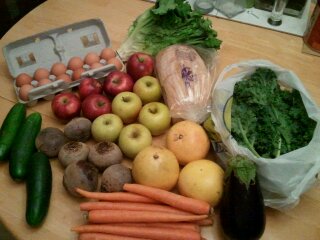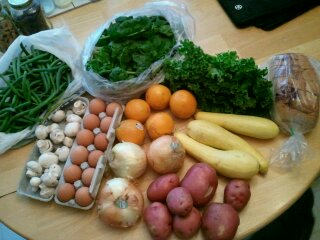These past couple weeks flew by for me, as we were traveling a lot. Fortunately our kid was very well-behaved in airplanes and slept almost the entire time we were in the air. As for me, I was less than thrilled with the culinary delights available at Newark airport: overpriced sandwiches and sad-looking shrinkwrapped fruit were my only alternatives to chips and candy. Unfortunately, it’s hard to sneak a decent meal past the TSA (no liquids over 3oz) or the border police (no fruits or vegetables). I’m so relieved to be back home.
Week 6 of the CSA brought us green leaf lettuce, apples, cucumbers, beets, carrots, grapefruit, kale, eggplant, bread (Great Harvest White) and eggs:

The good thing about cold storage items (the apples, beets, and carrots) is that they stayed perfectly fresh in the refrigerator while we were out of town. The bread, eggs, eggplant, cucumbers, and kale also held up fairly well in our absence. The lettuce was the only unfortunate casualty.
Week 7 of the CSA: green beans, spinach, green leaf lettuce, mushrooms, oranges, Vidalia onions, red potatoes, yellow squash, bread (Great Harvest Herb de Breezy Willow) and eggs:

We ate the lettuce with a quick dressing of mayonnaise, anchovy, garlic, olive oil, lemon juice, and Parmesan cheese. I had been aiming in the general direction of a Caesar salad, but I must have gotten the proportions wrong; it didn’t taste at all similar. Still, it turned out pretty tasty.
Another pleasant surprise was the pasta bake that we made with whole wheat rotini, ground beef, tomato sauce, sauteed mushrooms and onions, and mozzarella, feta, and cheddar cheeses; the flavors combined beautifully and masked the taste of the whole wheat pasta (which I personally find rather unpleasant). I like pasta bakes; they come together quickly and reheat easily on busy weeknights.
Finally, the yellow squash became sublime when sliced and tossed with olive oil, salt, pepper, and garlic powder, then roasted briefly at 400 degrees. I generally prefer green zucchini to yellow squash but this treatment was frankly delightful. I’ll be making it again in our toaster oven as the summer goes on.

Ack. I know I’ve been fussy about this before: the term CSA. CSAs in this area cannot produce the produce you’re receiving. You’re in more of a produce collective, or group purchasing with organized distribution system. Not as sexy as as CSA. But to the point of using the term CSA, it means something, namely, community-supported agriculture. And that means something: prepaying farmers and sharing in the risk and bounty of what is and isn’t produced.
I respectfully disagree. (And yes, we’ve had this conversation before.)
I think I do belong to a CSA, in the full sense of the acronym. When I show up at the farm every week, I’m recognized; we chat about my son and the farm dogs, and I swap recipes with the other shares. It definitely feels like a community to me.
Also, I do prepay for the season and I share in the risk; certainly more than one farm is involved, but if there’s a hard frost in Florida, I don’t get any citrus, and if there’s a drought in North Carolina, we don’t get the beautiful kale or spinach, either. I buy in knowing full well that we might get nothing more than last year’s cold storage apples and root vegetables week after week. (Fortunately that hasn’t happened. But I don’t get my money back if it does.)
Most importantly, I’m supporting agriculture practices that I agree with: farms that have made the effort to go organic, natural, or at least IPM. It’s just that they’re up and down the East Coast, as opposed to being within, say, a 100-mile radius.
Breezy Willow’s spring CSA is not a local one, and I have never pretended that it was; after your comments last year, I even made an effort to find out where each vegetable came from, and disclose it in the blog. But this year I have a new baby at home, and frankly I don’t have the time or patience to ask the farmer for the origin of each crop every week. I don’t mean to mislead anyone, but hopefully my readers are smart enough to figure out that oranges don’t grow in Maryland.
kat, I agree with you about how the local farmers are working together to support a community by meeting their produce and fruit needs using a collection of farmers.
Zahradka winter CSA used Florida farms to give us oranges and grapefruit all winter. For us, we did have risk. We shared in the risk of getting enough for our money paid, based on what Zahradka produced and purchased. Much of what we got was from the farm, but some of it was purchased by them. Some of the fruit came from cold storage from orchards outside of MD.
A few weeks the meat came from Treuth’s. Not from a local farmer. Most came from a partner farm on the MD/PA border.
I paid up front. Crossed my fingers. Got a few things that weren’t great, due to the weather. The rainy fall made some of the potatoes not the best we have ever tasted.
But we, as a community, gave money to Zahradka to keep them afloat over the winter, and took what they were able to supply within their network. I think that fits the term community supported.
AnnieRie, thanks for the input. I like that Zahradka did a winter CSA too. I know that CSAs originally started out as local enterprises, but when your locality isn’t producing much in the way of fresh fruits and veggies, it’s nice to have the flexibility to support farmers that are further away. I hope more farms will also offer this kind of option. And it’s nice to get things like citrus that just can’t be grown in MD.
You’re right in that the risk element is still there; when you pay up front, you’re gambling that it will work out for both you and the farmer(s).
I checked out Zahradka’s CSA. It’s amazing that they offer home delivery! That’s a lot of work for them.
Pingback: What Does the Term CSA Mean to You? « AnnieRie Unplugged
Great points, Kat. Maybe their is a new term to be coined: SuperCSA or something fun and bigger picture. Thanks for the engagement, perspective and communicated love of healthy produce!